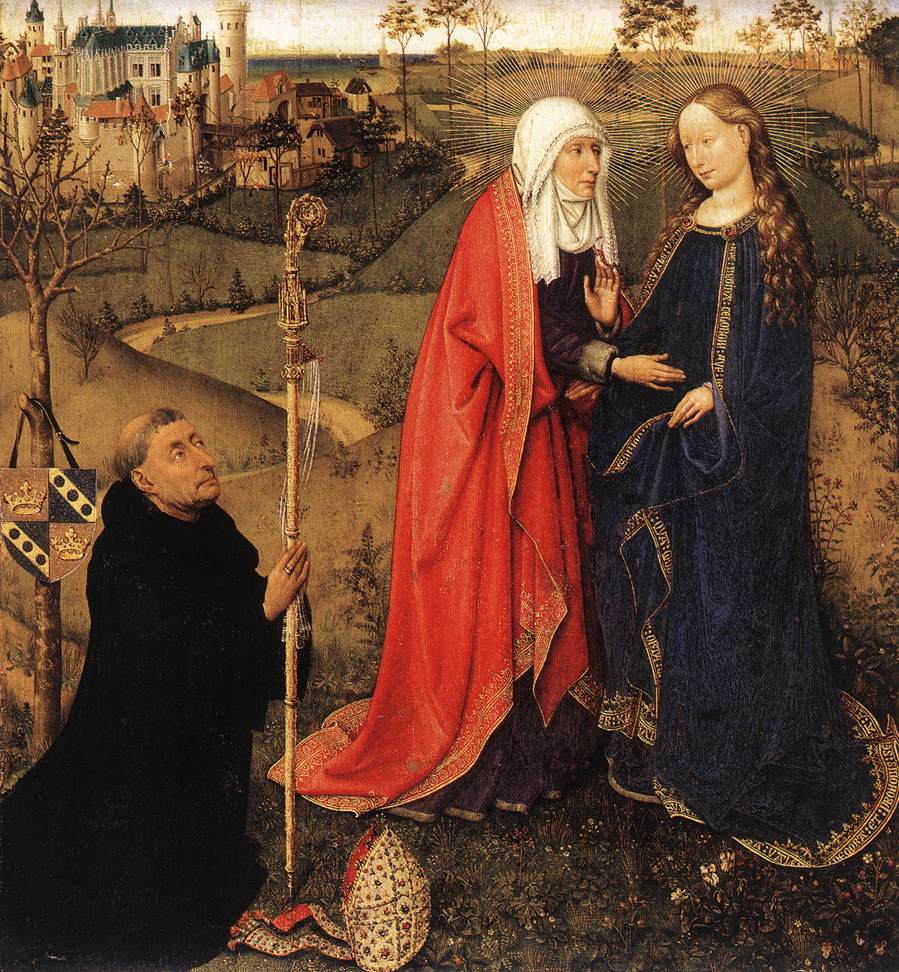Today’s readings focus on the mystery of the visitation:
Mary set out in those days
and traveled to the hill country in haste
to a town of Judah,
where she entered the house of Zechariah
and greeted Elizabeth.
When we read St Luke’s infancy narrative, and know something of the geography and history we are immediately struck with a difficulty.
The Annunciation takes place in Nazareth and immediately afterward we’re told that Mary set out in haste to the hill country of Judea to visit her kinswoman Elizabeth. The problem is, Mary is a young girl–maybe thirteen or fourteen years of age. The village of Ein Karem which is the traditional location of Zechariah and Elizabeth’s home is about seven miles south of Jerusalem. Nazareth is up in Galilee–a good 90-100 miles away from the Jerusalem-Bethlehem-Ein Karem. Isn’t it a bit of a stretch to imagine that a fourteen year old girl “makes haste” on her own–on a 100 mile journey–presumably on foot–to make a family visit?
Traveling in that climate in that hilly, desert like territory on foot is not a journey to be taken lightly. If you don’t know the lay of the land you might read the passage and imagine that the girl Mary simply took a hike up into the hills to visit her auntie. Not quite.
So what happened?
While doing research for my book The Secret of the Bethlehem Shepherds I came across a fascinating book entitled, Papyri and the Social World of the New Testament Sabine Huebner explores the evidence from ancient documents from Egypt. The “documents” are scraps of papyrus salvaged from libraries, trash dumps and old archives. They are ordinary, everyday documents–sales receipts, invoices, letters, personal notes, diaries and so forth. They reveal an enormous amount of detail about life in New Testament times for ordinary people.
Huebner explains why and how ordinary people would travel, and points out that travel in the ancient world was much more frequent and long distanced than we might think. She draws from letters written to family members planning a special journey–the sort of things anybody would write–“Looking forward to seeing you…time of arrival…is there anything I can get for you?” Huebner says, “Special events within extended families such as the birth of a child often prompted people to travel.”
In an extended section she explains how women travelled especially during times of pregnancy to be with other family members who were expecting. Usually they traveled with others in a group for safety and ease of travel. This aligns with the evidence in Luke 2:44 where we see Joseph and Mary traveling back from Jerusalem with a caravan of other pilgrims and we know from other evidence that the route from Galilee to the Jerusalem area was a well travelled road. Did they travel on foot? Some did. The donkey was the most common mode of transportation. Huebner records that donkeys were expensive for most people, but they could be rented.
We can conclude from this evidence that Mary probably joined one of the regular pilgrim caravans headed to Jerusalem from Galilee to visit Elizabeth.
In my book I speculate further on what the relationship between Elizabeth and Mary would have been. All we are told in Luke’s gospel is that Elizabeth is a “kinswoman.” The Protoevangelium of James is the early church document (2nd c) from which we received the traditions concerning Mary’s birth and childhood. The Protoevangelium says Mary was born in Jerusalem. An ancient Coptic tradition says St Joachim (Mary’s father) died when she was six and St Anne died when she was eight.
This leads us to wonder what the relationship was between Mary and Elizabeth. Was Elizabeth Mary’s aunt—the sister of Saint Anne? If Mary was an orphan, did Zechariah and Elizabeth care for her? Elizabeth and Zechariah were childless. Did they foster or even adopt Mary? Was Zechariah instrumental in arranging the betrothal of Joseph and his foster daughter Mary? The tradition from the Protoevangelium suggests that this was the case.
I realize this is speculation. We don’t have more information, but from what we do know and what the ancient traditions suggest we can speculate with some confidence to fill in the missing pieces.
Go here to get The Secret of the Bethlehem Shepherds and go here to take advantage of an Advent offer: both of my Christmas books in a bargain bundle.







Leave A Comment
You must be logged in to post a comment.